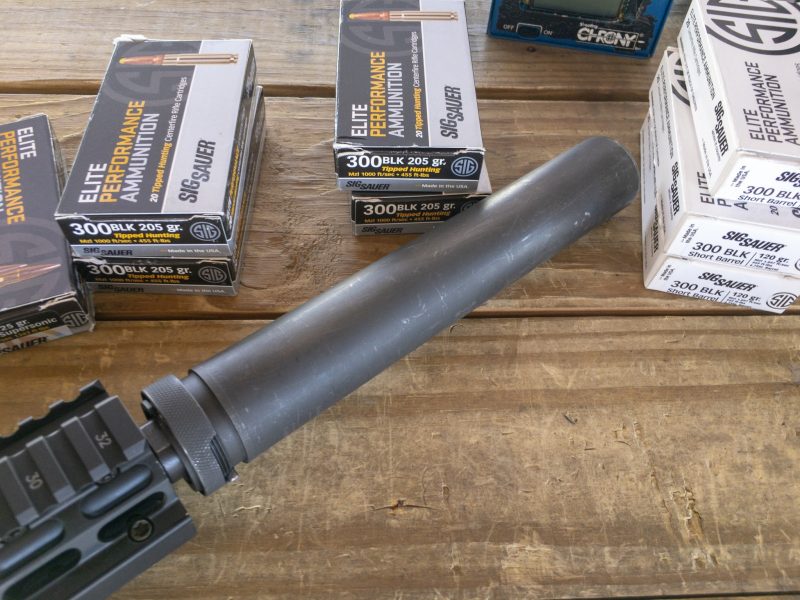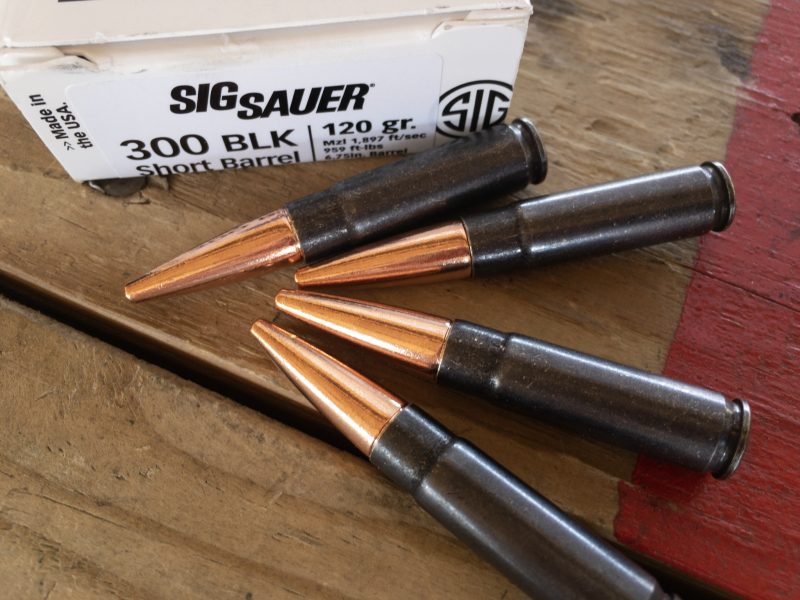Innovative New 300 Blackout Ammunition From Sig Sauer
Tom McHale 03.19.19

I’ve always been a fan of 300 Blackout, mainly because it’s a ballistic geek’s delight. The ability to swap between supersonic and subsonic performance simply by changing magazines the availability of loads ranging from 110-grain rockets to 240-grain bricks is compelling features. That’s a lot of performance variance out of the same rifle or pistol. Adding a suppressor makes the 300 Blackout shine. The suppressed supersonic loads are muted, at least for the muzzle blast components of noise, and the subsonic loads are shockingly quiet when fired through a silencer. The sound of “thud” comes to mind when the noise of those heavy subsonic bullets hitting the backstop dwarfs the volume of the shot itself.

There have been two big problems with 300 Blackout that have inhibited wider adoption, at least in my opinion. First, establishing simple aim points for such widely varying ammunition types through a standard scope requires math and memorizing custom hold-overs. Second, while it’s easy to make expanding supersonic ammunition for hunting or defensive use, subsonic loads have been a challenge. The standard 220-grain load will tumble when it hits an organic target because of its inherent instability, but up until now, a more traditional expanding bullet has been hard to find.
Previously the team at Sig Sauer Ammunition developed a variety of 300 Blackout offerings including 125-grain full metal jacket supersonic and 220-grain full metal jacket subsonic loads. The company also developed a 120-grain supersonic HT cartridge that fired an all-copper expanding bullet. This year, there are new members of the family, two of which are optimized for short-barrel 300 Blackout rifles and pistols where the 300 Blackout shines.
Here’s the thing about “short barrel” ammunition. Designing a bullet to perform to very specific penetration and expansion goals is a balancing act. Both factors work against each other. With all else being equal, more aggressive expansion will limit penetration as the bullet encounters more friction and loses velocity quickly. Bullets that penetrate deeply generally have slower or reduced expansion. Additionally, both factors are velocity sensitive. At higher than expected velocities, a bullet can expand too aggressively and penetrate less. Lower than expected velocities may not create an expansion effect at all.

So, “normal” ammunition is designed to balance penetration and expansion at “normal” velocities. When a firearm has a shorter than “normal” barrel length, it will launch any given bullet at a lower speed. Performance differs, but you can expect a 30 to 60 foot per second velocity decrease for each inch of barrel length reduction. Here, we’re working with a 7.5-inch barrel rather than a standard 16-inch rifle barrel, so we might see actual velocities from the pistol that are several hundred feet per second slower than the same ammo fired from a full rifle barrel. Manufacturers design this “short barrel” ammo to balance penetration and expansion at those reduced velocity levels.
With all of that said, the folks at Sig Sauer have developed three new 300 Blackout offerings, two of which are optimized for short barrel pistol or rifle use.
Sig Sauer Supersonic 300 Blackout SBR Elite Copper Duty 120-grain
This supersonic load is like the existing HT all-copper bullet but has notable differences. As the name implies, the bullet has been redesigned to expand at lower velocities. Factory velocity is rated at 1,897 feet per second when fired from a 6 ¾-inch barrel, delivering 959 foot-pounds of muzzle energy. You’ll notice that the case is coated with a black oxide finish, partly to provide a visual cue that it’s the short barrel version.

Sig Sauer Subsonic 300 Blackout Elite Tipped Hunting 205-grain
This subsonic round is rated at 1,000 feet per second, which should operate well below the speed of sound in most any normal atmospheric conditions. As a reference, here in South Carolina, the speed of sound is normally somewhere in the 1,130 feet per second range. It features a jacketed lead-core bullet with an unusual shape. More on that in a minute. This projectile features a polymer rounded tip which presumably aids both feeding and expansion at lower velocity. At the rated velocity, this 205-grain projectile will deliver 455 foot-pounds to the target. Sig recommends that you use a firearm with at least a nine-inch barrel with this particular load. The factory tested velocity from a 16-inch barreled rifle.

Sig Sauer Subsonic 300 Blackout SBR Elite Tipped Duty 205-grain
Coming out in April is a variant of the Tipped Hunting round, but for tactical use. The Tipped Duty round is also subsonic but designed for short barrel firearm use so the similar looking bullet is reconfigured to expand at lower velocity. The company recommends an eight-inch or shorter barrel for this one. Like the Tipped Hunting, it features the stepped bullet design and rounded polymer tip.
Shooting Configuration
I got my hands on two out of three of these loads, the Short Barrel 120-grain and the Tipped Hunting 205-grain. I should note that the 205-grain Tipped Hunting round is not optimized for short barrel use – it’s intended for full-length rifles and Sig recommends that you use a firearm with at least a nine-inch barrel. I tested it anyway with the Aero Precision 7.5-inch barreled upper, so just know that the results here are not official as I did not meet the factory spec. Therefore, they’ll be a bit slower than advertised and may not expand properly with my gun configuration. The Tipped Duty ammo should be out in the April time-frame so we’ll get our hands on some to test then.
Function so far has been perfect across the board using both standard Magpul and Lancer magazines. I did do all testing with a SilencerCo Specwar 762 suppressor attached because it seemed a shame not too. Besides, I think it’s probably illegal, or at least a violation of good taste and class to shoot subsonic rounds without a silencer.
Weird Subsonic Bullets
If you jumped right to the pictures, you might have noticed something strange about the appearance of the subsonic Tipped Hunting bullets. At first glance, they look more like a staged Saturn V rocket than a typical rifle projectile thanks to their stepped body design. There’s a good reason for this. The 300 Blackout cartridge case is a cut-down version of the .223 Remington and the cartridge uses the same magazines as the popular .223. The challenge is that most magazine ribs are placed squarely in the cartridge case neck area on the .223. Since that doesn’t exist in a shorter 300 Blackout case, the bullet itself aligns on that rib. To reliably cycle subsonic rounds, the clever folks at Sig designed the bullet to have the right diameter at the right place to sit in magazines properly. That means you can stuff a standard magazine full of 30 rounds and everything will work. I verified this and had no reliability issues at all with the subsonic Tipped Hunting rounds.
Trijicon 3×30 Compact ACOG Scope
I mounted a unique Trijicon ACOG optic on the Aero pistol upper. This particular model is a great fit for this 300 Blackout pistol as the low fixed magnification (3x) allow natural “both eyes open” shooting while providing enough magnification boost for accurate shooting out to a couple of hundred yards. Like other ACOG models, this one features dual illumination. A light gathering tube on top powers the bright green center crosshair in daylight conditions while Tritium makes it glow in dark conditions.

What really makes it interesting is the custom design features for the flexible 300 Blackout round. The reticle is graduated to accommodate both 115-grain supersonic and 220-grain subsonic rounds, so you can change magazines at will, and with no scope change, put rounds on target at a variety of distances. The crosshair bars mark supersonic projectile bullet holdover points while two round dots indicate hold points for subsonic rounds at 50 and 100-yard distances.
The two new Sig Sauer rounds weigh a little more and less for the supersonic and subsonic rounds respectively. Also, I’m shooting both from a short barrel configuration, so velocity also differs from the reticle calibration design. I zeroed this pistol with the Sig 120-grain Short Barrel rounds at 50 yards and see how things worked with both ammo types and the Trijicon 300 Blackout reticle.

With the scope adjusted so that the 120-grain SBR ammo impacted on the center crosshairs at 50 yards, I did some quick tests with the supersonic loads at 100. Accounting for group variance, I figured the point of impact was a hair less than an inch higher than the aim point. That’s close enough for me, so I decided to stick with the 50-yard zero.
Next up I wanted to see if the two subsonic aim points matched “close enough” to the points of impact. The Sig Sauer 205-grain Tipped Hunting loads were spot on at 50 yards and as near to “on target” as I would need at 100. As far as I’m concerned, this configuration is good to go, even with the slight variances in projectile weights and muzzle velocities from the design specs of the Trijicon reticle.
Velocity
Since I didn’t yet have the new Tipped Duty ammo, I went ahead and tested both the supersonic Elite Copper Duty and the subsonic Tipped Hunting rounds. I figured that the forthcoming Tipped Duty would be similar in terms of velocity and accuracy performance even through my 7.5-inch barrel test pistol is a bit below factory recommendations. That would only really matter for testing expansion and penetration performance anyway.
Setting up a Shooting Chrony Beta Master 15 feet down range, I clocked multiple-shot strings and averaged the recorded velocities for the two new ammo types. Since I had them, I also included some of the Sig 300 Blackout 125-grain FMJ ammo released a couple of years ago.
Accuracy
I’d shot this Aero Precision upper before with other types of ammunition and a higher magnification scope. At 100 yards, and with most ammo types, it would shoot five groups in the two to three-inch range from its short 7.5-inch barrel. With that baseline in mind, I set up targets at 50 yards. That distance seemed more appropriate for practical AR pistol use with the Trijicon 3x ACOG sight. Again, I shot multiple five-shot groups for both new ammo types and “control” groups of the Sig Sauer Elite Performance 125-grain Match bullet loads. After averaging the group sizes, here’s how they stacked up from the Aero upper.

Given what I’d recorded in the past with this particular upper, the 50-yard results were consistent with the performance past performance of the pistol itself, so no complaints there.

I’ve tested the 120-grain Sig Sauer Elite HT 300 Blackout ammo in the past and gotten fantastic results with expansion and penetration. These all-copper bullets expand into picture-perfect four petal blossoms that increased to over double their original diameter. The spent projectile sitting on my desk measures a whopping .63 inches across. Given the explosion of the AR-15 pistol market, I’m glad to see a short barrel optimized version in the supersonic category.
As for the subsonics, what’s not to love about that? Before, the easy availability of big and heavy bullets that would tumble when hitting a target was interesting, but there’s just something about a controlled expansion bullet the provides a level of confidence and precision. Whether for hunting or defensive use, I suspect these innovative expanding subsonics will breathe new life and enthusiasm into the 300 Blackout SBR and pistol market.


